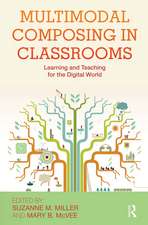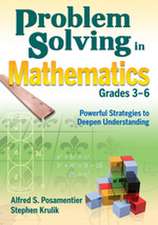Digital Technologies in Designing Mathematics Education Tasks: Potential and Pitfalls: Mathematics Education in the Digital Era, cartea 8
Editat de Allen Leung, Anna Baccaglini-Franken Limba Engleză Hardback – 21 oct 2016
| Toate formatele și edițiile | Preț | Express |
|---|---|---|
| Paperback (1) | 1111.53 lei 6-8 săpt. | |
| Springer International Publishing – 23 iun 2018 | 1111.53 lei 6-8 săpt. | |
| Hardback (1) | 1117.50 lei 6-8 săpt. | |
| Springer International Publishing – 21 oct 2016 | 1117.50 lei 6-8 săpt. |
Din seria Mathematics Education in the Digital Era
- 15%
 Preț: 642.68 lei
Preț: 642.68 lei - 24%
 Preț: 739.44 lei
Preț: 739.44 lei - 18%
 Preț: 782.42 lei
Preț: 782.42 lei - 15%
 Preț: 644.82 lei
Preț: 644.82 lei - 18%
 Preț: 1127.15 lei
Preț: 1127.15 lei - 18%
 Preț: 959.36 lei
Preț: 959.36 lei - 18%
 Preț: 952.26 lei
Preț: 952.26 lei - 24%
 Preț: 804.93 lei
Preț: 804.93 lei - 18%
 Preț: 990.93 lei
Preț: 990.93 lei -
 Preț: 438.10 lei
Preț: 438.10 lei - 18%
 Preț: 953.03 lei
Preț: 953.03 lei - 18%
 Preț: 889.92 lei
Preț: 889.92 lei - 24%
 Preț: 875.83 lei
Preț: 875.83 lei - 24%
 Preț: 752.35 lei
Preț: 752.35 lei -
 Preț: 360.15 lei
Preț: 360.15 lei - 15%
 Preț: 649.06 lei
Preț: 649.06 lei - 20%
 Preț: 573.77 lei
Preț: 573.77 lei -
 Preț: 394.29 lei
Preț: 394.29 lei -
 Preț: 389.88 lei
Preț: 389.88 lei - 15%
 Preț: 649.54 lei
Preț: 649.54 lei - 18%
 Preț: 1112.78 lei
Preț: 1112.78 lei
Preț: 1117.50 lei
Preț vechi: 1362.82 lei
-18% Nou
Puncte Express: 1676
Preț estimativ în valută:
213.86€ • 222.45$ • 176.55£
213.86€ • 222.45$ • 176.55£
Carte tipărită la comandă
Livrare economică 14-28 aprilie
Preluare comenzi: 021 569.72.76
Specificații
ISBN-13: 9783319434216
ISBN-10: 3319434217
Pagini: 368
Ilustrații: XVI, 352 p. 107 illus.
Dimensiuni: 155 x 235 x 22 mm
Greutate: 0.69 kg
Ediția:1st ed. 2017
Editura: Springer International Publishing
Colecția Springer
Seria Mathematics Education in the Digital Era
Locul publicării:Cham, Switzerland
ISBN-10: 3319434217
Pagini: 368
Ilustrații: XVI, 352 p. 107 illus.
Dimensiuni: 155 x 235 x 22 mm
Greutate: 0.69 kg
Ediția:1st ed. 2017
Editura: Springer International Publishing
Colecția Springer
Seria Mathematics Education in the Digital Era
Locul publicării:Cham, Switzerland
Cuprins
Introduction by Allen Leung and Anna Baccaglini-Frank.- Section One.- Chapter 1 How the software used affects task design: Kate Mackrell and Christian Bokhove.- Chapter 2 The historical development of Digital Mathematics Environment: Peter Boon and Paul Drijvers .- Section Two.- Chapter 3 Techno-pedagogic task design in mathematics: Allen Leung.- Chapter 4 How the software design can affect students’ mathematical productions: Samuele Antonini, Anna Baccaglini-Frank, Allen Leung, Maria Alessandra Mariotti.- Chapter 5 Using variation and feedback in tasks to increase learning: Christian Bokhove.- Section Three.- Chapter 6 Design digital tasks: Interactive Diagrams as resource and constraint: Michal Yerushalmy & Elena Naftaliev.- Chapter 7 E-books and Lesson Study: a teaching experiment on intercultural dialogue: Masami Isoda, Maria G. Bartolini Bussi, Alessandro Ramploud.- Chapter 8: What can you infer from this example? Applications of online, rich-media tasks for enhancing pre-service teachers’ knowledge of the roles of examples in proving: Orly Buchbinder, Iris Zodik and Gila Ron.- Section Four.- Chapter 9 Issues emerging from the experiences of designing microworlds for young children: Anna Baccaglini-Frank.- Chapter 10: Designing tasks for the social and tangible mathematics in TouchCounts : Nathalie Sinclair.- Chapter 11 Designing digital mathematics learning scenarios for a more inclusive school mathematics:Lulu Healy and Solange Hassan Ahmad Ali Fernandes.- Chapter 12 Designing innovative learning activities to face up to difficulties in algebra of dyscalculia students: how exploit the functionality of AlNuSet: Elisabetta Robotti.- Section Five.- Chapter 13 Role and potential of using an interactive whiteboard and the relationship with teachers' practices: Floriane Wozniak.- Chapter 14 Designing assessment tasks in a dynamic geometry environment: Nathalie Sinclair and Marta Venturini .- Chapter 15 Designing tasks to promote discoursein math classroom: Janete Bolite Frant, Andreia Maciel Barbosa, Wellerson Quintaneiro.- Chapter 16 Designing for mathematical applications and modelling tasks in technology rich environments: Vince Geiger.- Section Six.- Chapter 17 Tensions in the design of mathematical technological environments: Tools and Tasks: Alison Clark-Wilson.- Chapter 18 The Learning by Design paradigm for Mathematics Teaching: Eugenia Koleza, Eugenia Arvanitis.- Chapter 19 Feedback and didactical variable in the design of task with Cabri Elem technology: Sophie Soury-Lavergne and Michela Maschietto.
Recenzii
“Leung and Baccaglini-Frank’s Digital technologies in designing mathematics education tasks: Potential and pitfalls offers much to readers interested in the potential of technology to transform mathematics teaching and learning. I applaud the editors and contributors for creating a volume that highlights both the potential and need for caution when designin and presenting students with digital tasks.” (Kathryn M. Rich, Educational Studies in Mathematics, Vol. 103, 2020)
“This is a book on the benefits and drawbacks on using digital technology in designing lessons and activities in the math classroom. … the book offers its reader a very diverse and up-to-date study of these technologies. I highly recommend this book for those instructors who want some fresh ideasor are in search for valuable digital tool-based task design approaches for students to engage in meaningful mathematical experiences.” (Peter T. Olszewski, MAA Reviews, maa.org, May, 2017)
Textul de pe ultima copertă
This book is about the role and potential of using digital technology in designing teaching and learning tasks in the mathematics classroom. Digital technology has opened up different new educational spaces for the mathematics classroom in the past few decades and, as technology is constantly evolving, novel ideas and approaches are brewing to enrich these spaces with diverse didactical flavors. A key issue is always how technology can, or cannot, play epistemic and pedagogic roles in the mathematics classroom. The main purpose of this book is to explore mathematics task design when digital technology is part of the teaching and learning environment. What features of the technology used can be capitalized upon to design tasks that transform learners’ experiential knowledge, gained from using the technology, into conceptual mathematical knowledge? When do digital environments actually bring an essential (educationally, speaking) new dimension to classroom activities? What are some pragmatic and semiotic values of the technology used? These are some of the concerns addressed in the book by expert scholars in this area of research in mathematics education. This volume is the first devoted entirely to issues on designing mathematical tasks in digital teaching and learning environments, outlining different current research scenarios.
Caracteristici
First volume devoted entirely to issues on designing mathematical tasks in a digital teaching and learning environment Provides the latest research insights into design models and mathematics education tasks within different digital environments Introduces adaptations of existing theoretical constructs and new theoretical perspectives used in designing tasks in digital learning environments Traces developments and rationales for educationally sound purpose of digital technology in the mathematics classroom Includes supplementary material: sn.pub/extras













